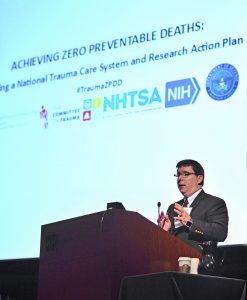In April a broad coalition of trauma stakeholders met in Bethesda, Md., to begin implementing the recommendations of the landmark Zero Preventable Deaths report. The report, which was developed by the National Academies of Sciences, Engineering and Medicine (NASEM), proposes the creation of a joint civilian-military trauma system in the U.S. The goals are to maintain the readiness of military trauma teams and eliminate preventable trauma deaths in all settings.
Trauma System News recently interviewed Ronald Stewart, MD, FACS, chair of the ACS Committee on Trauma (COT), and Robert Winchell, MD, FACS, chair of the Trauma Systems Evaluation and Planning Committee of the COT. They talked about the practical challenges of implementing the ZPD vision.
Q. What top challenges were identified at the Zero Preventable Deaths conference?

Winchell: When the NASEM report was originally chartered, it was initially conceived as an effort to translate the lessons learned during our military experience in Iraq and Afghanistan back to the civilian world. But in June 2016 when the report came out, it was substantially different in that it focused very much on the vision of a joint national trauma system that combines the military and civilian systems — with an aspirational focus of “zero preventable deaths” whether on the battlefield or on the highway.
The challenge right now is not in disseminating the findings of the report so much as in operationalizing the findings. So the goal of the conference was to develop a framework and a consensus and a large stakeholder group to be able to do that. Dr. David Hoyt, as executive director of the American College of Surgeons, and the leadership of the Committee on Trauma all felt strongly that moving this initiative along was a very high priority. And we have dedicated ourselves to trying to make that happen.
Q. One big issue for the joint trauma system is governance. Did any decisions come out of the conference?
Winchell: I think it’s fair to say, both from a military standpoint and a civilian standpoint, that we all agree there needs to be a central, cohesive, high-level leadership with the commitment to move this joint national trauma system forward. I would say this kind of leadership has been the biggest vacuum on the civilian side, simply because I would argue there’s not been a lot of strong central governance on many policy things since 1776 probably.
So there is overall buy-in that central leadership of the joint trauma system is a good idea. The specifics get much harder. The NASEM report clearly placed the locus of civilian side leadership in the White House. And while most of us generally think that’s a good idea from an operational standpoint, it’s not easy. As you actually start talking to people in government, it becomes clear that there are plusses and minuses to almost any governance structure that one could put together. What ultimately happens will probably be a mixture of what we might theoretically conceive to be the best, what is practical within existing structures, and to some degree what is timely and fits with other priorities within those organizations.
Stewart: I think on the military side it’s easier because they’re used to a top-down governance system. And all the decisions in the military, you could argue, already flow from the president through the Department of Defense. The civilian trauma system has developed on a more local and regional level with the focus at the state or even county level. This system works well in many places, but leaves gaps across the country. I would favor federal support for infrastructure and standards that are implemented at the regional level.
Q. Has the White House sent any signals on this?
Winchell: They have not, and we have not yet formulated exactly whom to reach out to. During our ZPD dissemination meeting in very early November, we didn’t know who would be in the White House. In January things were still very much up in the air, and things still haven’t completely jelled yet in the governmental transition. So we are working with our advocacy people within the College and building a broader expert group with other professional stakeholder groups to decide the best way to do that.
Q. Within the executive branch, what department should be the lead agency for trauma?
Winchell: There are many different plusses and minuses, depending on which audience you talk to. The people who wrote the report thought the joint trauma system belongs somewhere in Department of Health & Human Services (HHS). The idea is that trauma is fundamentally a healthcare issue, so this lead agency for trauma belongs somewhere under HHS. I think from a strategic standpoint, that still seems to make the most sense.
In terms of advocacy, one big thing to come out of this conference is a shift in strategy. For a long time we’ve put forward trauma as a major public health problem, which it is by any metric, and that it’s in need of a big public health policy solution. But I think we’ve had 50 years to show that that argument has not been compelling to any number of governments on both sides of the political spectrum, and that if we’re going to make this work, we need to find a new approach. What Zero Preventable Deaths is putting forward is that we are facing enormous issues of readiness and preparedness — military combat preparedness but also domestic preparedness for either mass casualties or potential terrorist acts and even domestic violence. So in terms of advocacy, this initiative is putting more focus on the fact that a trauma system is a key element in the preparedness piece.
Stewart: That approach has not been at the forefront of our advocacy positions, and it was strongly felt that that’s how this needs to be couched. So beyond trauma as a public health issue, trauma is a preparedness issue that may in part belong under an emergency preparedness component of the government. It really is a matter of national security and homeland security — plus it’s the most important health problem facing our children. Therefore, the Department of Homeland Security would be another possible lead for this effort.
Q. The ZPD conference addressed the issue of federal versus local control. What were the conclusions?
Winchell: There was a clear consensus that this needs to be a federal system — not with the noun “Federal” but with the adjective “federal.” In other words, there needs to be a strong central directive, but the details need to be worked out locally. There is no question that an approach like, “We’re going to make all the policy in Washington and make everybody step in line” — that’s not an approach that will work for trauma systems, given the diversity and the heterogeneity of the various places that are trying to operationalize this.
So we clearly see that there needs to be a high-level directive that states or municipalities or regions need to address the problem of injury. And with that directive, there will be a directive regarding the high-level components that make up a trauma system. But those elements should be developed by the trauma community and not by any federal agency or by the White House.
The actual nuts and bolts of the system would be developed by a broad coalition of the providers of the trauma community. That model is how transplant works, you might argue, in terms of a nationalized system around organ procurement. There is a central authority, but in fact the rules are made by and in the transplant community. And I would argue that the trauma community has already generated most of this information. It’s just a matter of codifying it
Q. What is the vision for improving the quality and availability of trauma data?

Stewart: There was a strong consensus at the April conference that we need improved data, particularly on what I refer to as “the two extremes.” In the trauma community we have a relative blind spot when a death occurs at the scene, particularly when it occurs prior to EMS arrival. So we don’t see those deaths in the hospital, and EMS might not even see them. So they never really enter into the trauma system database, and that’s a gap. People recognize that if we’re going to get to zero preventable deaths, we have to know what those deaths are and when they occur. That would impact, for example, where you might put EMS resources or what you might do to improve access.
And at the other extreme, a gap that exists in almost everybody’s data is the long-term patient reported outcomes. There was a general consensus that we need to try to work towards data linkage to get more information on those prehospital deaths and also on long-term outcomes after somebody leaves the hospital or leaves a rehabilitation center.
Q. There was some discussion about extending the ZPD concept to zero preventable deaths and disability.
Stewart: Yes, and that gets to the issue of long-term function. We think the disability piece is very important, and that’s where we need data on long-term functional outcomes and outcomes from the patient’s point of view. This is critical. This recognition came out loud and clear at these “ZPDD” meetings.
Q. One of the key proposals is embedding military surgeons within civilian trauma centers. But are there enough seriously injured patients to keep everyone’s skills sharp?
Winchell: That’s an open question. There’s a strong understanding that military readiness for the next war has to be maintained within a peacetime system. That clearly involves a cooperative training paradigm with the civilian system. People are addressing the idea that many of the skills of the combat surgeon have to be developed and maintained through skills that may not be directly applicable to military surgery. In other words, we have to find ways for military surgeons to maintain their readiness skills that don’t include taking care of 15 people blown up by an IED every month.
So there’s a clear understanding that joint training is part of the paradigm. Exactly how that works out is very much in development. There are existing programs that embed military surgeons into high-volume trauma centers, and those work well in several big centers. The military has also done a lot of preliminary work with the College to identify the necessary skills of a frontline surgeon and ways those skills might overlap with what are more traditionally thought of as “elective” procedures rather than emergency or trauma procedures.
Q. That gets to the question of resources. Funding for trauma is currently dismal. How will the Zero Preventable Deaths initiative change that?
Stewart: The group didn’t reach any conclusion about whether we should go to one specific federal agency or another to advocate for funding. What we did agree on is that we should be working with our federal and state partners to improve funding for trauma systems, especially trauma system infrastructure and trauma research. Funding for system infrastructure in areas that have gaps is a very important short-, medium- and long-term goal. And improved funding for trauma research is critical, because if you think of a trauma system that is fairly mature, the only way that system will reduce death and disability is to innovate to improve care. The system has to come up with improved ways to care for patients, and the only way to do that is by understanding what works and what doesn’t. That has to be done with high-quality research.
Winchell: The answer also might include changing our advocacy focus a little bit. “Improved funding” has been the thrust of a lot of trauma-related advocacy over the last 20 years or so. That has resulted in a number of bills that were authorized but never had any funds appropriated. So our current effort is changing the thrust of our advocacy to seeking central leadership.
And if you look at current directions within the healthcare system, we should probably start to look for some way to use alternative payment models. There is the potential to improve trauma system funding overall through a population-based payment structure.
Q. Like a regional “bundled payment” for trauma?
Winchell: Yes, I think that’s a good way to look at it. If you think about how different value-based payment models work right now, they are quote-unquote “population-based” — but in the sense of the population of everybody with heart disease or the population everybody with kidney disease. But for trauma, what we would need is a system that encompasses the population — in other words, everybody who lives in a given area.
This effort could involve building a coalition of the providers and payers in a region and putting together a payment model that actually incentivizes system economies. For example, not duplicating things you don’t have to duplicate and incentivizing the right patient flow. I think that this approach would ultimately save money over the current system, because the current financial incentives don’t favor system behavior. The things that favor EMS don’t favor the hospitals. The hospitals are sort of pitted one against the other and against the system. Trying to rewrite the rules of payment — and using the stimuli that already exist without re-creating the entirety of the healthcare system — is a more achievable goal. The idea is to bend payment in a way that matches system goals.
Stewart: I think Dr. Winchell has a great point. That alternative payment system is similar to the ideas previously put forward by Dr. Martin Croce from Memphis. I think this would have promise. Also, along these lines, there is a general consensus that if we improve trauma systems, there will be a net financial positive for our society. Recent data from Arkansas — published in the Journal of the American College of Surgeons — shows that money devoted to the trauma system had a positive return on investment for the state and for the government.
Winchell: And I think that fits in with the larger theme — while you might argue that the NASEM report argues for some major revolutionary changes in how things are done, the practical implementation will in many ways be more evolutionary. This effort is not necessarily creating entirely new systems, but leveraging existing initiatives and existing programs in a way that serves the end goal better.
Stewart: Multiple people made the point that the problem we’re talking about is the most important health problem for our children — and it’s also the most important health problem for people who we depend upon to put their lives at risk in times of conflict. So we feel that this investment in creating a joint trauma system is vitally important.


